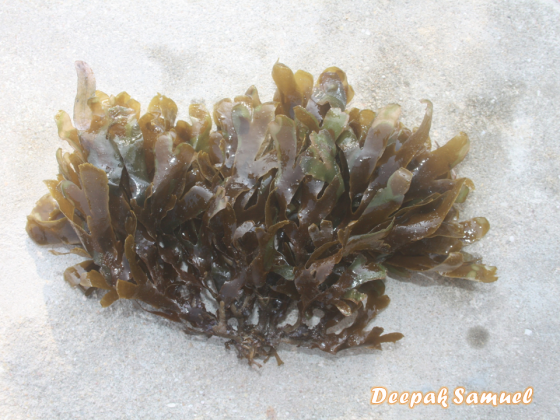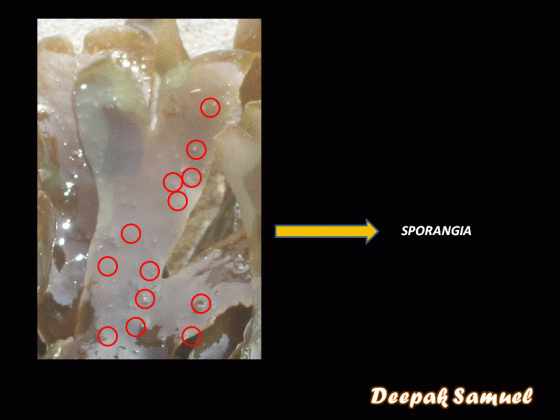The brown seaweed/ algae Stoechospermum Polypoidioides (often mentioned Stoechospermum marginatum) is an alga possessing forked structure. It is a common species in the Palk Bay and Gulf of Mannar regions of the east coast of India. They have also been recorded from Gujarat, Ratnagiri, Malvan, Goa, Karwar, Honawar and Batkal along the west coast of the peninsula. This species has no economic value to the coastal fishing community but has been studied extensively for its biological activity observed from its extracts.
The forked brown seaweed/ algae grow to 40 cm length with average lengths of 20-30 cm and 8-11 breadth. The thallus is flat (a plant body that is not differentiated into stem and leaves and lacks true roots and a vascular system) and erect. It is dichotomously branched (forking appearance) without a midrib. A midrib is a long strengthened vein along the middle. Fertile plants of the forked brown seaweed/ algae can be easily identified with crowded Sporangia on the marginal dark lines. Sporangium is a receptacle where asexual spores are formed for reproduction. The spores are transported in water and settle down once they identify a suitable substrate.
Stoechospermum polypoidioides thrives well in the intertidal zone (the zone of the shore between the high-water mark and low-water mark) from the water’s edge at a mean distance from sea level of 1 meter (3 feet). Scientists* have researched on the special anti-tumorigenic potential of polypehnols from five distinctive brown algae in four human pancreatic cancer cells. Out of the five studied brown algae the forked brown seaweed/ algae is one. This is purely because of the antioxidant property exhibited by the seaweed polyphenols. Even Diterepins (Terepenoids) have been reported* from the forked brown seaweed Stoechospermum polypoidioides. They are also used as a source for alginate production and manufacture of organic fertilizers.
Taxonomic position Kingdom: Chromista Subkingdom: Harosa Infrakingdom: Heterokonta Phylum: Ochrophyta Subphylum: Phaeista Infraphylum: Limnista Superclass: Fucistia Class: Phaeophyceae Order: Dictyotales Genus: Stoechospermum Species: S. polypoidioides Author: (J. V. Lamouroux) J. Agardh, 1848 IUCN Status Not Assessed (NA) References
- Scientists* – Aravindan, S., Delma, C. R., Thirugnanasambandan, S. S., Herman, T. S. & Aravindan, N.Anti-Pancreatic Cancer Deliverables from Sea: First-Hand Evidence on the Efficacy, Molecular Targets and Mode of Action for Multifarious Polyphenols from Five Different Brown-Algae. Plos One 8, e61977 (2013).
- Reported* – Paula, Joel Campos De, Vallim, Magui A., & Teixeira, Valéria Laneuville. (2011). what are and where are the bioactive terpenoids metabolites from Dictyotaceae (Phaeophyceae). Revista Brasileira de Farmacognosia, 21(2), 216-228. Epub May 13, 2011. Retrieved April 12, 2014, from http://www.scielo.br/scielo.php?script=sci_arttext&pid=S0102-695X2011000200004&lng=en&tlng=en. 10.1590/S0102-695X2011005000079.
© Deepak Samuel, April 2014



Interesting Information specially taxonomic part sir.
thanks prince.. do keep reading…
Very informative, would like to know more about economically important algae sp.
Basically economically important species belong to the red seaweeds (Rhodophyceae), brown seaweeds (Phaeophyceae)and green seaweeds (chlorophyceae). Red is harvested for the extraction of agar, brown is extracted for carageenan and algin while green is used for edible purposes. some examples of red are HYPNEA MUSCIFORMIS, KAPPAPHYCUS ALVAREZII, EUCHEMA COTTONI brown include SARGASSUM WIGHTII, PADINA TETRASTOMATICA and greens include CAULERPA RACEMOSA, ULVA LACTUCA. Good luck!!
Hey very nice blog!
thanks for stopping by.. do keep reading…
Very good blog! Do you have any tips for aspiring writers?
I’m planning to start my own site soon but I’m a little lost on everything.
Would you advise starting with a free platform
like WordPress or go for a paid option? There are so many options out there that I’m completely overwhelmed ..
Any ideas? Thanks a lot!